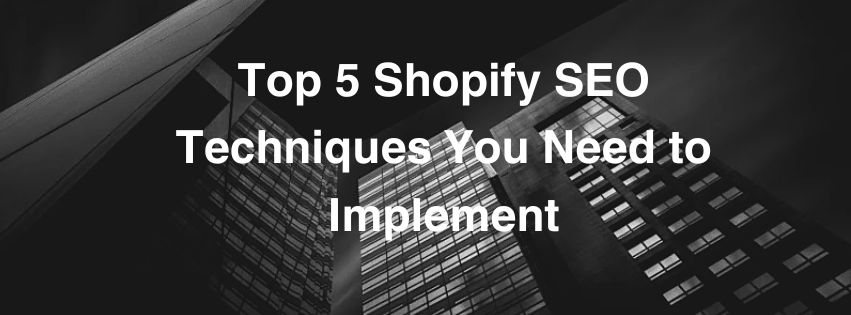In the competitive world of eCommerce, optimising your Shopify store for search engines is crucial to attract more visitors and increase sales. Here are five essential SEO techniques specifically tailored for Shopify:
1. Optimise Your Product Pages
Your product pages are the heart of your Shopify store. To improve their SEO:
-
Keyword Research:
Use tools like Google Keyword Planner or SEMrush to find relevant keywords with good search volume.
-
Optimised Titles and Descriptions:
Incorporate your primary keywords naturally into product titles, meta descriptions, and throughout the product descriptions.
-
High-Quality Images:
Use high-resolution images with descriptive filenames and alt text to improve visibility in image search results.
2. Improve Site Speed and Mobile Responsiveness
Site speed and mobile responsiveness are critical factors for both user experience and SEO:
-
Use a Fast Theme:
Choose a lightweight Shopify theme that prioritises speed and performance.
-
Optimise Images and Scripts:
Compress images and minify CSS, JavaScript, and HTML files to reduce load times.
-
Mobile-Friendly Design:
Ensure your Shopify store is fully responsive on all devices to provide a seamless browsing experience.
3. Build High-Quality Backlinks
Backlinks from reputable sites signal authority to search engines and improve your Shopify store’s SEO:
-
Guest Blogging:
Write guest posts on industry-related blogs and include a link back to your Shopify store.
-
Partner with Influencers:
Collaborate with influencers in your niche who can link to your products or store.
-
Create Shareable Content:
Develop valuable content such as infographics, guides, or videos that encourage others to link back to your site.
4. Utilise Shopify SEO Apps and Plugins
Take advantage of Shopify apps and plugins designed to enhance your SEO efforts:
-
SEO Apps:
Install SEO apps like SEO Manager or Plug in SEO to automate tasks like meta tag optimization and keyword suggestions.
-
Image Optimisation Apps:
Use apps like TinyIMG or Crush.pics to automatically compress and optimise images for faster loading times.
-
Schema Markup:
Implement schema markup using apps like JSON-LD for SEO to help search engines understand your store’s content and improve visibility in SERPs.
5. Regularly Update and Promote Content
Fresh and relevant content not only engages your audience but also boosts your SEO rankings:
-
Blog Posts and Guides:
Publish informative blog posts, how-to guides, or industry insights related to your products.
-
Social Media Integration:
Share your content on social media platforms to drive traffic and increase visibility.
-
Email Campaigns:
Use email marketing to promote new content, product updates, or special offers to your subscribers.
Conclusion
Implementing these five Shopify SEO techniques can significantly enhance your store’s visibility and attract more organic traffic. By focusing on optimising product pages, improving site speed, building quality backlinks, leveraging SEO apps, and regularly updating content, you can establish a strong SEO foundation for long-term success.
Remember, for advanced SEO strategies and tailored guidance, consider consulting with an organic SEO agency that can provide specialised insights and support.
FAQs:
1. Why is SEO important for my Shopify store?
SEO (Search Engine Optimisation) is crucial for your Shopify store because it helps improve your visibility in search engine results. This means more potential customers can find your products organically, leading to increased traffic and sales.
2. How can I find the right keywords for my Shopify store?
You can find relevant keywords using tools like Google Keyword Planner, SEMrush, or Ahrefs. Look for keywords that are relevant to your products, have good search volume, and moderate competition. Incorporate these keywords naturally into your product titles, descriptions, and content.
3. What role do backlinks play in Shopify SEO?
Backlinks from reputable websites act as “votes of confidence” for your Shopify store in the eyes of search engines. They signal authority and trustworthiness, which can improve your search rankings. Focus on building quality backlinks through guest blogging, influencer partnerships, and creating shareable content.
4. How can I improve site speed for my Shopify store?
To improve site speed, choose a fast-loading Shopify theme, compress images, and minify CSS, JavaScript, and HTML files. Ensure your store is mobile-responsive, as Google considers mobile-friendliness a ranking factor. Utilise Shopify apps and tools to automate and streamline the optimization process.
5. What are the benefits of using SEO apps and plugins on Shopify?
SEO apps and plugins help streamline and automate SEO tasks, such as meta tag optimization, keyword suggestions, and image compression. They can also assist in implementing schema markup, which helps search engines better understand your store’s content and improves visibility in search results.
6. How frequently should I update content on my Shopify store?
Regularly updating your content, such as adding new blog posts, product descriptions, or guides, signals to search engines that your site is active and relevant. Aim to publish high-quality content consistently and promote it through social media and email marketing to attract more visitors and enhance SEO.
Also Read : Advanced Technical SEO Tricks to Boost Your Site’s Ranking

